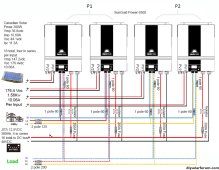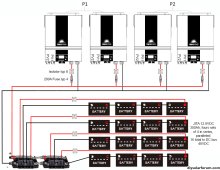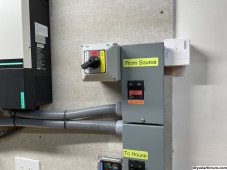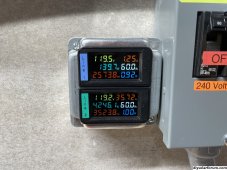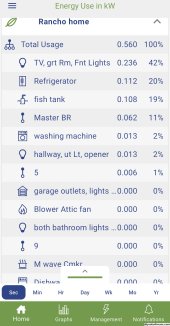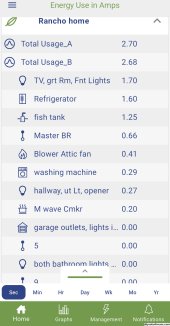garetwo
New Member
Electrician with negligible knowledge of PV systems…for now.
Online documentation. https://drive.google.com/file/d/1FAa6VnEkGG1d4d6sBfqJ82VOCE5lMgB6/view?usp=drive_link
There were two SunGold Power older model SP6548 each providing 120VAC, together providing 240VAC to a small loadcenter. Power was from a 6kw solar array and twelve batteries.
SunGold said we should not run the small (under 10k) generator directly to the Gen/Utility inputs because the built-in charger would have a hard time with the supplied power. SunGold implied using a 15kw generator would be better, but there are threads in this forum where smaller generators are used by tweaking the frequency and setting the charger output to low amps.
So, the inverter AC inputs were connected to utility via 60-amp breakers. AND the generator was used to manually charge the batteries through a pure sine wave inverter. The client would turn the utility feed to the inverters off, forcing solar/battery usage, then manually charge the batteries as they ran low.
The system is now four SB6548 inverters (two each 2P1 and two each 2P2 180 degree) and 16 batteries – 4 banks of 4 in series. I am confused with 4S4P versus 4P4S, so please do not ask me (yet). The batteries are JITA LifePO4 12.8Vdc 300Ah.
I messed up the initial step, from two inverters to four, by taking the output power from the first two 180 degrees out inverters and connecting them to the same phase via breakers. So, when the breakers were engaged, they immediately tripped. I figured I was about to buy inverters. But, after correcting my mistake, the units seemed to function.
When I got home, the client told me they lost power, or more accurately, things were not working – like the garage door opener sounded weird and only opened a few inches. There seems to be an issue with loads not getting proper voltage SOMETIMES. I have not been there when this happens, so I have not been able to measure anything. We need to figure out how to download the error logs.
I know I need to try and cause the failure so I may see better what is going on. But, for now, I am asking for thoughts on the problem as well as how to properly set up the inverters. All four inverters are online, all sixteen batteries are connected, but I do not understand all the settings. I am asking for help with respect to:
12 – is 44VDC safe?
How does this impact 29 LOW DC CUTOFF VOLTAGE?
13 – what is lowest this may be set at?
26 – What is bulk charging mode?
What does it do?
27 – What is floating charging voltage?
What does it do?
29 – Should this value be less than 12 VOTAGE BACK TO UTILITY?
30-36 – Should we use equalization?
41 – Should this stay disabled?
Online documentation. https://drive.google.com/file/d/1FAa6VnEkGG1d4d6sBfqJ82VOCE5lMgB6/view?usp=drive_link
There were two SunGold Power older model SP6548 each providing 120VAC, together providing 240VAC to a small loadcenter. Power was from a 6kw solar array and twelve batteries.
SunGold said we should not run the small (under 10k) generator directly to the Gen/Utility inputs because the built-in charger would have a hard time with the supplied power. SunGold implied using a 15kw generator would be better, but there are threads in this forum where smaller generators are used by tweaking the frequency and setting the charger output to low amps.
So, the inverter AC inputs were connected to utility via 60-amp breakers. AND the generator was used to manually charge the batteries through a pure sine wave inverter. The client would turn the utility feed to the inverters off, forcing solar/battery usage, then manually charge the batteries as they ran low.
The system is now four SB6548 inverters (two each 2P1 and two each 2P2 180 degree) and 16 batteries – 4 banks of 4 in series. I am confused with 4S4P versus 4P4S, so please do not ask me (yet). The batteries are JITA LifePO4 12.8Vdc 300Ah.
I messed up the initial step, from two inverters to four, by taking the output power from the first two 180 degrees out inverters and connecting them to the same phase via breakers. So, when the breakers were engaged, they immediately tripped. I figured I was about to buy inverters. But, after correcting my mistake, the units seemed to function.
When I got home, the client told me they lost power, or more accurately, things were not working – like the garage door opener sounded weird and only opened a few inches. There seems to be an issue with loads not getting proper voltage SOMETIMES. I have not been there when this happens, so I have not been able to measure anything. We need to figure out how to download the error logs.
I know I need to try and cause the failure so I may see better what is going on. But, for now, I am asking for thoughts on the problem as well as how to properly set up the inverters. All four inverters are online, all sixteen batteries are connected, but I do not understand all the settings. I am asking for help with respect to:
12 – is 44VDC safe?
How does this impact 29 LOW DC CUTOFF VOLTAGE?
13 – what is lowest this may be set at?
26 – What is bulk charging mode?
What does it do?
27 – What is floating charging voltage?
What does it do?
29 – Should this value be less than 12 VOTAGE BACK TO UTILITY?
30-36 – Should we use equalization?
41 – Should this stay disabled?
Attachments
Last edited:



